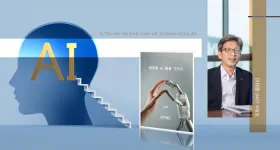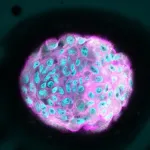(Press-News.org) PROVIDENCE, R.I. [Brown University] — The fact that humans and other living organisms can develop and grow from a single cell relies on a process called embryonic development. For healthy tissue to form, cells in the embryo have to organize themselves in the right way in the right place at the right time. When this process doesn’t go right, it can result in birth defects, impaired tissue regeneration or cancer. All of which makes understanding how different cell types organize into a complex tissue architecture one of the most fundamental questions in developmental biology.
While researchers are still some distance from fully understanding the process, a group of Brown University scientists has spent the past handful of years helping the field inch closer. Their secret? A branch of mathematics called topology.
The research team at Brown, made up of biomedical engineers and applied mathematicians, created a machine learning algorithm using computational topology that profiles shapes and spatial patterns in embryos to study how these cells organize themselves into tissue-like architectures. In a new study, they take that system to the next level, opening a path to studying how multiple types of cells assemble themselves.
The work is described in npj Systems Biology and Applications.
“In tissues, there may be differences in how one cell adheres to the same cell type, relative to how it adheres to a different cell type,” said Ian Y. Wong, an associate professor in Brown’s School of Engineering who helped develop the algorithm. “There's this interesting question of how these cells know exactly where to end up within a given tissue, which is often spatially compartmentalized into distinct regions.”
For example, in an animal embryo, the outer layer of cells goes on to form skin, the middle layer forms muscle and bone, while the innermost layer forms the liver or lungs. Cells within each layer will preferentially adhere to each other, sorting apart from cells in other layers that go on to form other parts of the body.
In the 1970s, scientists discovered that cells within frog embryos could be gently separated apart and when they were mixed back together, they would spontaneously rearrange into their initial organization. This occurs because the cells have different affinities for each other, and as they assemble and cluster, certain topological patterns of linkages and loops are preserved.
“In the context of these spatial arrangements of tissues, you can learn a lot from what's there, but also from what’s not there at the same time,” said Dhananjay Bhaskar, a recent Brown Ph.D. graduate who led the work and is now a postdoctoral researcher at Yale University.
The Brown researchers showed in 2021 how their approach can profile the topological traits of one cell type that organizes into different spatial configurations and could make predictions on it.
The hiccup with the original system was that it is a slow and labor-intensive process. The algorithm painstakingly compared these topological features one-by-one against those in other sets of cell positions to determine how topologically different or similar they are. The process took several hours and, essentially, held the algorithm back from its full potential in understanding how cells assemble themselves, and from being able to easily and accurately compare what happens when conditions change — a key in breaking down what happens when things go wrong.
In the new study, the research team begins to address that limitation with what’s called persistence images. These images are a standardized picture-like format for representing topological features, enabling rapid comparison across large datasets of cell positions.
They then used those images to train other algorithms to generate “digital fingerprints” that capture the key topological features of the data. This drives down the computation time from hours to seconds, enabling the researchers to compare thousands of simulations of cell organization by using the fingerprints to classify them into similar patterns without human input.
The researchers say the goal is to work backward and infer the rules that describe how different cell types arrange themselves based on the final pattern. For instance, if they tinker with how certain cells are more adhesive or less adhesive, the researchers can identify how and when dramatic alterations occur in tissue architecture.
The approach has the potential to be applied to understanding what happens when the developmental process goes off track and for laboratory experiments testing how different drugs can alter cell migration and adhesion.
“If you can see a certain pattern, we can use our algorithm to tell why that pattern emerges,” Bhaskar said. “In a way, it’s telling us the rules of the game when it comes to cells assembling themselves.”
Other Brown authors include William Y. Zhang, who earned a bachelor’s degree in computer science in 2022; Alexandria Volkening, who earned her Ph.D. from Brown in 2017 and is now an assistant professor of mathematics at Purdue; and Bjorn Sandstede, a Brown professor of applied mathematics.
The research was supported by Brown University’s Data Science Institute, the National Institute of General Medical Sciences, and the National Science Foundation. The research was conducted using computational resources and services at Brown’s Center for Computation and Visualization.
END
Using topology, Brown researchers advance understanding of how cells organize themselves
The research can help unlock answers around how cells assemble themselves during embryonic development and what happens when this fundamental process goes awry.
2023-09-14
ELSE PRESS RELEASES FROM THIS DATE:
A call for better energy system models to enable a decarbonized future
2023-09-14
Energy system models fail to accurately represent energy storage and might recommend decarbonization strategies that make electric grids less reliable.
Policy makers and utilities need robust energy system models to determine the best strategies to decarbonize the world’s electric grids. But most existing models were designed for grids operating more than a decade ago. Today’s grids are much different. New technologies such as solar power and grid energy storage are being rapidly deployed. To accommodate these and other technologies, utilities must run grids in completely new ways.
Improvements are needed in energy system ...
Stretching the truth: New research reveals negative effects of exaggerative political statements
2023-09-14
Justifying policies through unsubstantiated or slightly invalid arguments can have a significantly negative effect on the public opinion of politicians, according to new research from City, University of London.
With increasing scrutiny on global government policies in a ‘post-truth’ era, and in the aftermath of the Covid-19 pandemic that polarised international responses and reactions to the virus, an increased focus has been placed on policymakers to justify their actions and validate reasons for taking decisions.
Short of lying, this can often politicians “stretching arguments” – making invalid claims that are difficult to both prove and disprove.
The study, ...
Aegis Consortium funds research aimed at reducing the threat of future pandemics
2023-09-14
The Aegis Consortium, an initiative of the University of Arizona Health Sciences, awarded approximately $650,000 in seed funding to eight pilot research projects in the areas of pandemic control, prediction or preparedness; post-acute effects of pandemics on individuals and societies; and the resilience of built and natural environments.
“As we explore the challenges of pandemics such as COVID-19, we will continue to expand our investigative reach with domestic and international research teams to provide a range ...
UNIST releases generative AI utilization guide to promote smart usage of ChatGPT
2023-09-14
Under the leadership of UNIST Education Innovation Task Force, a comprehensive guidebook titled ‘A Guide to the Use of Generatvie AI‘ was released on July 28, 2023. This guidebook presents alternative approaches to utilize generative AI, like ChatGPT more efficiently rather than simply prohibiting their use. With a focus on teachers, researchers, and students, the 50-page guidebook provides practical examples of generative AI utilization.
To gain insights into the purpose and development ...
Preventing the tissue's response to stiffness may be key to slowing the progression of breast tumors
2023-09-14
Cells are capable of translating mechanical changes into biological responses. This process is known as mechanotransduction and plays a fundamental role in the progression of solid tumors, such as breast cancer.
It is well-established that a common mechanical alteration in cancer progression involves tissue hardening. This stiffness is precisely what is detected during self-examinations or breast palpations for potential tumor detection. The stiffness of breast tissue triggers a chain reaction, inducing tension within cells and distorting their nuclei. Ultimately, this nuclear deformation activates genes responsible for controlling cell proliferation, which are closely associated ...
Members of the National Association of Neonatal Nurses support efforts to promote racial equity
2023-09-14
September 14, 2023 — More than 90% of the active members of the National Association of Neonatal Nurses (NANN) believe the organization should pursue racial equity work, and many have specific suggestions for a strategic plan. This feedback comes from the survey results the association released this month in its journal, Advances in Neonatal Care. The journal is published in the Lippincott portfolio by Wolters Kluwer.
"Neonatal care has advanced significantly in recent years, yet ...
Webb Confirms accuracy of universe’s expansion rate measured by Hubble, deepens mystery of Hubble constant tension
2023-09-14
The rate at which the universe is expanding, known as the Hubble constant, is one of the fundamental parameters for understanding the evolution and ultimate fate of the cosmos. However, a persistent difference called the “Hubble Tension” is seen between the value of the constant measured with a wide range of independent distance indicators and its value predicted from the big bang afterglow.
NASA’s James Webb Space Telescope provides new capabilities to scrutinize and refine some of the strongest observational evidence for this tension. Nobel Laureate Adam Riess from the Johns Hopkins University and ...
Penn Medicine’s Carl June, MD, to receive 2024 Breakthrough Prize in Life Sciences
2023-09-14
PHILADELPHIA – CAR T cell therapy pioneer Carl June, MD, the Richard W. Vague Professor in Immunotherapy in the Perelman School of Medicine at the University of Pennsylvania and director of the Center for Cellular Immunotherapies (CCI) at Penn Medicine’s Abramson Cancer Center, has been named a winner of the 2024 Breakthrough Prize in Life Sciences for the development of chimeric antigen receptor (CAR) T cell immunotherapy, a revolutionary cancer treatment approach in which each patient’s T cells are modified to target and kill their cancer cells. The invention sparked a new path in cancer care, harnessing the power of patients’ own immune systems, a once-elusive ...
New research published by Nature Food reveals food is primary driver of the EU-27’s outsized Ecological Footprint
2023-09-14
One quarter of food consumed in the EU-27 originates from outside the region, highlighting the vulnerability of the EU’s food system.
New research coordinated by Global Footprint Network’s sustainability scientists in collaboration with food system experts published the article “EU-27 Ecological Footprint was primarily driven by food consumption and exceeded regional biocapacity from 2004 to 2014” today in Nature Food. The way food is provided to and consumed by Europeans represents ...
Rivers are rapidly warming, losing oxygen; aquatic life at risk, study finds
2023-09-14
UNIVERSITY PARK, Pa. — Rivers are warming and losing oxygen faster than oceans, according to a Penn State-led study published today (Sept. 14) in the journal Nature Climate Change. The study shows that of nearly 800 rivers, warming occurred in 87% and oxygen loss occurred in 70%.
The study also projects that within the next 70 years, river systems, especially in the American South, are likely to experience periods with such low levels of oxygen that the rivers could “induce acute death” for certain species of fish and threaten aquatic diversity at large.
“This is a wake-up call,” ...
LAST 30 PRESS RELEASES:
Tracing the quick synthesis of an industrially important catalyst
New software sheds light on cancer’s hidden genetic networks
UT Health San Antonio awarded $3 million in CPRIT grants to bolster cancer research and prevention efforts in South Texas
Third symposium spotlights global challenge of new contaminants in China’s fight against pollution
From straw to soil harmony: International team reveals how biochar supercharges carbon-smart farming
Myeloma: How AI is redrawing the map of cancer care
Manhattan E. Charurat, Ph.D., MHS invested as the Homer and Martha Gudelsky Distinguished Professor in Medicine at the University of Maryland School of Medicine
Insilico Medicine’s Pharma.AI Q4 Winter Launch Recap: Revolutionizing drug discovery with cutting-edge AI innovations, accelerating the path to pharmaceutical superintelligence
Nanoplastics have diet-dependent impacts on digestive system health
Brain neuron death occurs throughout life and increases with age, a natural human protein drug may halt neuron death in Alzheimer’s disease
SPIE and CLP announce the recipients of the 2025 Advanced Photonics Young Innovator Award
Lessons from the Caldor Fire’s Christmas Valley ‘Miracle’
Ant societies rose by trading individual protection for collective power
Research reveals how ancient viral DNA shapes early embryonic development
A molecular gatekeeper that controls protein synthesis
New ‘cloaking device’ concept to shield sensitive tech from magnetic fields
Researchers show impact of mountain building and climate change on alpine biodiversity
Study models the transition from Neanderthals to modern humans in Europe
University of Phoenix College of Doctoral Studies releases white paper on AI-driven skilling to reduce burnout and restore worker autonomy
AIs fail at the game of visual “telephone”
The levers for a sustainable food system
Potential changes in US homelessness by ending federal support for housing first programs
Vulnerability of large language models to prompt injection when providing medical advice
Researchers develop new system for high-energy-density, long-life, multi-electron transfer bromine-based flow batteries
Ending federal support for housing first programs could increase U.S. homelessness by 5% in one year, new JAMA study finds
New research uncovers molecular ‘safety switch’ shielding cancers from immune attack
Bacteria resisting viral infection can still sink carbon to ocean floor
Younger biological age may increase depression risk in older women during COVID-19
Bharat Innovates 2026 National Basecamp Showcases India’s Most Promising Deep-Tech Ventures
Here’s what determines whether your income level rises or falls
[Press-News.org] Using topology, Brown researchers advance understanding of how cells organize themselvesThe research can help unlock answers around how cells assemble themselves during embryonic development and what happens when this fundamental process goes awry.




